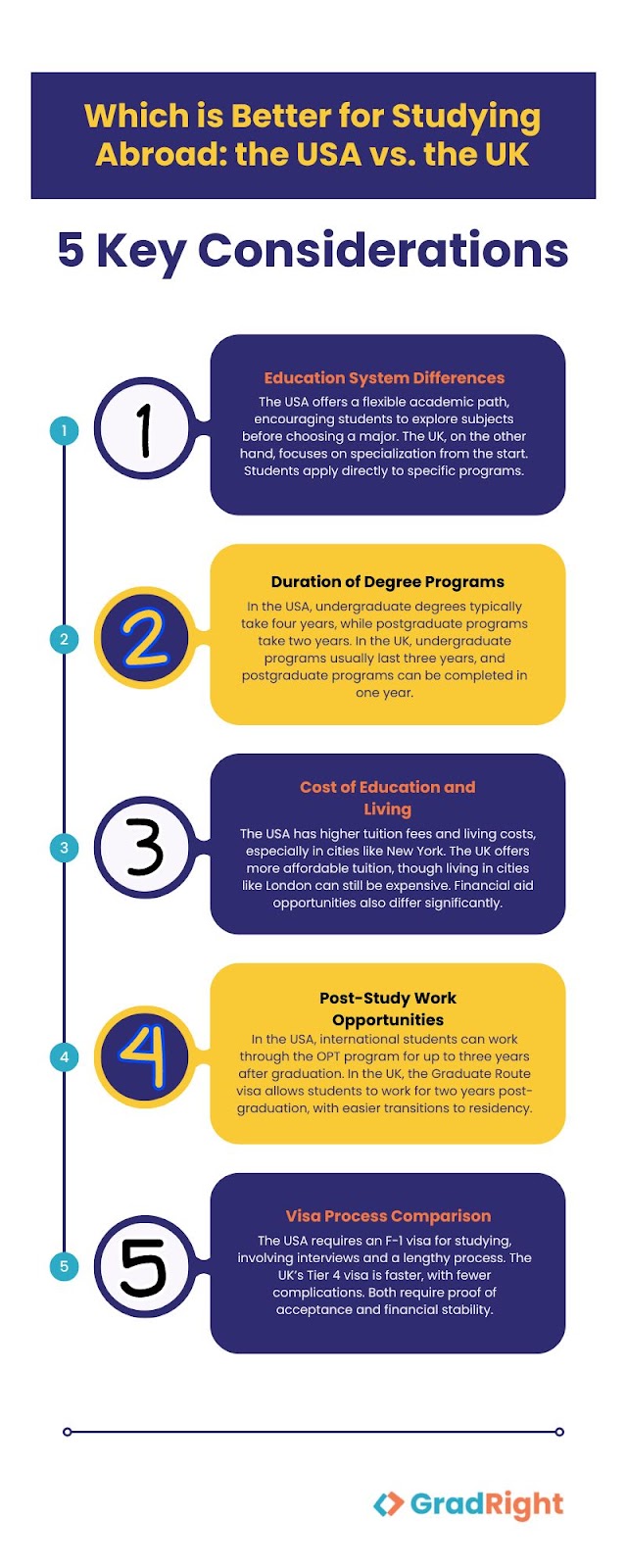Summary
- For postgraduate degrees, a master’s degree in the UK is generally completed in one year, while a similar degree in the USA often takes two years.
- In the USA, you’d apply to a Master of Finance programme, and choose to specialize in international finance in year two or year three.
- The first major factor to consider is the structure of the education system in the country you’re interested in.
Choosing between the USA and the UK for international students is tough. Both countries have excellent educational standards, offer good employment (and migration) opportunities, and welcome international students.
However, one of these is better than the other, and the answer depends on what you are looking for as an international student. In this guide, we’ll cover the most important aspects of pursuing higher education in the USA and UK, such as academic structures, costs, admission requirements, and post-study options.
When you’ve understood the basics that we’ll cover in this article, you’ll be equipped to make an informed decision about where to study.

Major factors to consider when choosing to study in the USA or the UK
There are seven key differences to consider when you’re deciding between the USA and the UK for your higher education. These differences are as follows:
-
Education System
The first major factor to consider is the structure of the education system in the country you’re interested in.
In the USA, students typically follow a more flexible academic path, especially at the undergraduate level. American universities encourage students to explore various subjects in their first two years before deciding on a major.
This can be beneficial if you are unsure of your preferred field of study or want to keep your options open.
In contrast, the education system in the UK focuses on specializations from the start. In the UK, you choose a specialized program (e.g. a Master of International Finance) and apply directly to it. From day one, you will specialize in international finance. In the USA, you’d apply to a Master of Finance programme, and choose to specialize in international finance in year two or year three.
-
Teaching and learning styles
While both countries are known for high academic standards, the teaching and learning experience varies significantly.
In the UK, learning tends to be more self-directed, with fewer contact hours and more emphasis on independent study.
USA universities, on the other hand, often offer more frequent interactions with faculty and a continuous assessment model, which includes quizzes, essays, and class participation.
-
Duration of Programs
The duration of study is another critical factor in comparing Master’s programs in the USA vs. the UK.
In the USA, undergraduate programs typically last four years, whereas in the UK, most undergraduate programs are completed in three years. The exceptions in the UK are programs taught in Scotland, where a four-year programme is followed.
For postgraduate degrees, a master’s degree in the UK is generally completed in one year, while a similar degree in the USA often takes two years. That said, there are a great number of programs in the USA that are only one academic year long.
-
Cultural and social environment
The cultural differences between the U.S. and U.K. are not to be overlooked. The U.S. is known for its diverse and dynamic society, where individualism is often celebrated, and the scale of the country means you’ll experience different regional cultures.
The U.K., though smaller, offers a rich blend of history and tradition, with distinct regional cultures across England, Scotland, Wales, and Northern Ireland. When choosing between the USA and the UK for international students, consider the type of cultural and social environment you’ll thrive in.
-
Cost of study and living Expenses
The cost of living in the U.K. for international students tends to be lower than in many parts of the USA. However, this will vary based on your lifestyle and the location of your university.
It wouldn’t make sense to compare a University in New York, with one in Galway, for instance. But overall, academic and living expenses in the U.K. are more affordable than in the USA. We’ll cover this in more detail in a separate section in this guide.
-
Scholarship and financial aid opportunities
Lastly, the availability of scholarships and financial aid is a significant factor for many international students.
In the USA, there are a variety of merit-based and need-based scholarships specifically for international students, and many universities offer robust financial aid packages. The UK also provides scholarships, but overall, the funding opportunities are lesser than in the USA.
For example, in the USA, you could be a teaching assistant, a research assistant, a research fellow (only in PhD. level programs), get a bursary, get a grant, or a scholarship. In the UK, those options are much less common, and the main financial aid available to international students are scholarships and bursaries.
However, the tuition fees in the UK are often much lower than comparable programs in the USA. Depending on your financial situation, it’s essential to investigate which country offers more opportunities to fund your education. We’ll discuss these options in more detail towards the end of this guide.
With the major factors done, we’ll cover the main differences between the USA and UK education systems, that we mentioned in point #1 and #2 above.
Also Read: Top Exams For Studying Abroad [Comprehensive Guide]
Differences between the UK and the USA education systems
As we mentioned above, universities in the USA and the UK take vastly different approaches to education. Here is a table outlining the main differences between the two education systems:
| USA | UK |
| Degrees typically take 4 years. | Undergraduate degrees usually take 3 years (4 in Scotland). |
| Students study a broad range of subjects initially. | Students focus on their chosen subject from the start. |
| Majors are declared in second or third-year. | There is no major “declaration”, as your program is specialized from day one. |
| Campus life is central to the university experience. | Academic life is the primary focus. |
| Sports and extracurricular activities are highly emphasized. | Clubs and societies exist but are less central. |
| The academic year is usually split into two semesters. | The academic year is divided into three terms, called trimesters. |
| The U.S. uses a GPA system based on continuous assessment throughout the program. | The U.K. uses a classification system (First, Upper Second, etc.), typically based on final exams. |
With those differences done, we’ll talk about the most popular programs in each country.
Popular programs in the USA vs. the UK
According to a July 2024 study published on analytics site Statista.com, these are the most common majors of study for international students in the USA:
- Maths and Computer Science: 240,230 students
- Engineering: 202,801 students
- Business and Management: 157,281 students
- Social Sciences: 85,998 students
- Physical and Life Sciences: 84,830 students
- Fine and Applied Arts: 51,689 students
- Health Professions: 34,856 students
The data is for the 2022-2023 academic year, compiled across 160,000 individual students.
A lot of the fields that are popular in the USA are also popular in the UK. According to data published by HESA (the UK’s Higher Education Statistics Authority), these are the most popular majors for students in the UK:
- Business and management: 587,165 students
- Subjects allied to medicine: 369,455 students
- Design, and creative and performing arts: 188,535 students
- Social sciences: 285,540 students
- Law: 146,590 students
- Computing: 180,640 students
- Psychology: 141,065 students
Knowing which majors are popular should help you decide between the USA and the UK as an international student.
With that done, let’s look at the top 5 universities from both the USA and the UK.
Also Read: 5 Most Affordable Universities in the USA for Indian Students
Top universities in the USA vs. the UK
These are the best UK and USA universities for international students as per the 2025 QS World University Rankings:
| Rank | University | Location |
| 1 | Massachusetts Institute of Technology (MIT) | Cambridge, United States |
| 2 | Imperial College London | London, United Kingdom |
| 3 | University of Oxford | Oxford, United Kingdom |
| 4 | Harvard University | Cambridge, United States |
| 5 | University of Cambridge | Cambridge, United Kingdom |
| 6 | Stanford University | Stanford, United States |
| 9 | UCL (University College London) | London, United Kingdom |
| 10 | California Institute of Technology (Caltech) | Pasadena, United States |
| 11 | University of Pennsylvania | Philadelphia, United States |
| 27 | The University of Edinburgh | Edinburgh, United Kingdom |
Eligibility criteria and admission requirements for the USA & the UK
Each university will tailor their admission requirements, and these can differ even from program to program. However, below is a general guideline of the “bare minimum” requirements for admission to either the USA or the UK.
- For postgraduate applications, you will need to have an undergraduate degree, and it must be from a recognized university. At minimum, the program should have been three years long. If your degree certificate is not in English, you’ll also need an official translation.
- For universities located in the USA, you’ll need a GPA of at least 3.0, averaged across all your years of study. For universities located in the UK, you’ll usually need to have a lower second degree for most universities.
- You’ll need to have at least two letters of recommendation, both professional (work). If you do not have two professional (work) references, you can provide one professional and one academic.
- Depending on your field of study, you’ll also need competitive, standardized exam scores. For finance, business, engineering, or computer programs, GMAT and GRE scores are submitted. For law programs, students submit their LSAT scores. For health profession programs, MCAT scores are required.
- Some universities also require you to submit an SOP (Statement of Purpose), which is like a cover letter for your application.
- Most universities in both countries also require at least one English proficiency exam, out of the IELTS, TOEFL, PTE Academic, or Duolingo Test of English. However, if your undergraduate degree was four years long, and taught in English, this can be waived upon request.
In the next section, we will take a look at the cost of living as well as study expenses in both countries.
Also Read: Why Study in USA? Top Reasons To Pursue Higher Studies in the US
Study expenses and cost of living in the USA vs. the UK
Both the USA and the UK have a similar standard of living, However, the cost of living is different.
Here is a table that shows the cost of living for a two-year master’s program in both the countries. Note that the amount you eventually spend will vary based on factors like lifestyle, scholarships, and duration of your program.
| # | Description | USA | USA (INR)* | UK | UK (INR)** |
| 1 | Average Annual Tuition Fees (Master’s Program) | $20,000 – $45,000 per year | ₹16,64,000 to ₹37,44,000. | £10,000 – £25,000 per year | ₹10,38,500 to ₹25,96,250 |
| 2 | Average Monthly Rent for 1 Bedroom (City Center) | $1,500 – $3,000 | ₹1,24,500 – ₹2,49,000 | £1,000 – £1,500 | ₹1,02,000 – ₹1,53,000 |
| 3 | Average Monthly Rent for Shared Accommodation | $700 – $1,500 | ₹58,100 – ₹1,24,500 | £500 – £900 | ₹51,000 – ₹91,800 |
| 4 | Average Monthly Utilities (Electricity, Heating, Cooling) | $150 – $250 | ₹12,450 – ₹20,750 | £100 – £150 | ₹10,200 – ₹15,300 |
| 5 | Monthly Transport Costs (Public Transport Pass) | $70 – $120 | ₹5,810 – ₹9,960 | £50 – £80 | ₹5,100 – ₹8,160 |
| 6 | Groceries (Monthly Average) | $300 – $600 | ₹24,900 – ₹49,800 | £200 – £300 | ₹20,400 – ₹30,600 |
| 7 | Dining Out (Meal in an Inexpensive Restaurant) | $15 – $25 per meal | ₹1,245 – ₹2,075 per meal | £10 – £20 per meal | ₹1,020 – ₹2,040 per meal |
| 8 | Books and Study Materials (Per Year) | $500 – $1,000 (Per Year) | ₹41,500 – ₹83,000 (Per Year) | £400 – £800 (Per Year) | ₹40,800 – ₹81,600 (Per Year) |
| 9 | Health Insurance (Per Year) | $1,500 – $2,500 (Per Year) | ₹1,24,500 – ₹2,07,500 (Per Year) | £500 – £800 (Per Year) | ₹51,000 – ₹81,600 (Per Year) |
| 10 | Personal Expenses (Clothing, Entertainment, etc.) | $200 – $400 | ₹16,600 – ₹33,200 | £150 – £300 | ₹15,300 – ₹30,600 |
| 11 | Visa Application Fees (One-Time) | $160 (F-1 visa) | ₹13,280 | £363 (Tier 4 visa) | ₹37,000 |
| 12 | Student Visa Health Surcharge (Per Year) | N/A | N/A | £470 (Per Year) | ₹47,940 (Per Year) |
| 13 | Travel (Return Ticket to Home Country) | $800 – $1,500 (Per Trip) | ₹66,400 – ₹1,24,500 | £500 – £900 (Per Trip) | ₹51,000 – ₹91,800 |
| 14 | Technology & Internet (Monthly) | $50 – $100 | ₹4,150 – ₹8,300 | £30 – £50 | ₹3,060 – ₹5,100 |
| 15 | Mobile Phone Plan (Monthly) | $40 – $60 | ₹3,320 – ₹4,980 | £15 – £30 | ₹1,530 – ₹3,060 |
| 16 | Gym Membership (Monthly) | $30 – $70 | ₹2,490 – ₹5,810 | £20 – £40 | ₹2,040 – ₹4,080 |
| 17 | Miscellaneous (Laundry, Toiletries, etc.) | $50 – $100 | ₹4,150 – ₹8,300 | £40 – £80 | ₹4,080 – ₹8,160 |
*$1 = ₹83
*£1 = ₹102
This table is only intended to be used as a general guide. With that covered, we will now look at the visa process for either country.
The visa process for international students in the USA vs. the UK
For the USA, you will need an F-1 visa, and for the UK, you will need a Tier-4 visa to attend any program longer than 6 months.
Here is the visa application process for the USA (F-1 Visa):
- First, you should be holding an offer of admission from an institute that has been approved by SEVP.
- The school will issue you an I-20 form.
- You need to pay the SEVIS fee.
- After that, you need to fill out the DS-160 form, which can only be done online.
- Then, you must book and attend an interview at a USA Embassy or Consulate.
- Bring all required documents to your interview.
- If approved, you’ll receive your visa stamp in your passport.
Here is the visa application process for the UK (Tier-4 Visa):
- You must have an unconditional offer from a licensed student sponsor.
- Your sponsor will provide you with a Confirmation of Acceptance for Studies (CAS).
- Apply for the visa online and pay the application fee.
- Pay the Immigration Health Surcharge.
- Provide biometric information at a visa application center.
- Submit supporting documents as required.
- You may need to attend an interview.
- If successful, you’ll receive your visa.
Also note that for programs shorter than nine months, you’d still need the full living expenses in your bank account. This is £1,334 per month for programs inside London (including the Fringe), and £1,023 per month elsewhere.
In the next section, we’ll look at working while studying for international students in the USA and the UK.
Working while studying in the USA vs. the UK
Each country has slightly different rules that apply to part-time work for international students. You are not allowed to work full-time on a student visa in either country, except off-term.
In the USA:
- International students are allowed to work a maximum of 20 hours per week, to get work experience.
- During summer and winter breaks, students can work full-time on campus.
- In the USA, you can only work on-campus for the first (academic) year of study.
- After the first academic year, students may be eligible for off-campus employment through Curricular Practical Training (CPT) if it’s related to their field of study.
In the UK:
- International students can work up to 20 hours per week during term time if studying at a degree level or above.
- Students can work full-time during scheduled breaks and holidays.
- Postgraduate students doing research degrees can work full-time throughout the year.
- Some programs may have restrictions on work hours due to program requirements.
The next section will outline the options that are open to international students after their degree in either the USA or the UK, as each is different.
Post-study work options in the USA vs. the UK
Post-study opportunities are a major factor in deciding between the USA vs. the UK for international students. Here’s a breakdown of post-study options in each country:
In the USA:
Optional Practical Training (OPT) allows students to work for 12 months after graduation in their field of study. Graduates of STEM fields can extend the OPT period for an additional 24 months, totaling 36 months of work authorization.
The H-1B visa lottery system is available for longer-term employment, with annual quotas and specific employer requirements. There is a possibility to transition to other visa categories based on employment (e.g., O-1 for exceptional ability) or investment (E-2).
Some universities offer specific programs to help international students find OPT opportunities.
In the UK:
The Graduate Route allows international students to stay and work for 2 years after graduation (3 years for PhD graduates) without sponsorship.
Start-up and Innovator visas are offered for those wanting to start a business, with endorsement from an approved body. The Global Talent visa is available for individuals showing exceptional talent or promise in specific fields like sciences, humanities, and arts.
There is a possibility to switch between visa categories while in the UK, offering flexibility for career changes.
We’ll talk about each country’s immigration policies in the section that follows.
Immigration policies in the USA vs. the UK
In the USA:
The main pathway available here is to transition to an H1-B visa after your OPT period expires. The process is extraordinarily competitive especially for Indians (as there is a cap on the number of H1-B visas issued to candidates from each country). However, the high salaries that you can earn even in the (maximum of) 3 years’ OPT are enough to keep international students keen on applying to master’s programs in the USA.
In the UK:
The Graduate Route visa offers a straightforward path for graduates to work for up to 2 years (3 years for PhDs). Afterward, students can apply for a Skilled Worker visa, with fewer restrictions and a more accessible pathway to permanent residency.
Next, we discuss permanent residency options for each country.
Permanent residence (PR) in the USA vs the UK
Both countries offer permanent residence to foreign nationals. However, simply completing a degree here does not guarantee you PR, or even a job. However, an in-country degree can make finding a job easier.
For the USA:
- In the USA, PR is known as getting a “Green Card”.
- The process can take decades.
- Employment-based Green Cards have annual quotas and country caps.
- Some categories, like EB-1 for individuals with extraordinary ability, can be faster.
For the UK:
- In the UK, PR is called “Indefinite Leave to Remain” or “ILR”.
- After a year of holding ILR, you may apply for naturalization.
- Most work visas lead to ILR after 5 years of continuous residence.
- The graduate work scheme allows you to work in the country for a maximum of three years.
- Within those three years, you must transition to another type of visa for the remaining two or three years.
Both countries require applicants to meet specific criteria, including continuous residence, good character, and language proficiency. The UK system may offer a more straightforward path to PR for some skilled workers.
In the next section, we’ll talk about job opportunities in either country.
Also Read: What is the H-1B visa for USA? Fees, Process, Eligibility, Registrations & More
Job opportunities in the USA vs. the UK
Here is a table that outlines the differences between the USA and the UK in terms of job opportunities:
| Factor | USA | UK |
| Key Sectors | Tech, finance, healthcare, engineering, and STEM fields | Finance, healthcare, engineering, tech, and innovation |
| Work Authorization Post-Graduation | Optional Practical Training (OPT) for 12 months (36 months for STEM) | Graduate Route visa allows 2 years of work without a job offer |
| Long-Term Employment | Requires employer sponsorship, typically through an H-1B visa | No immediate sponsorship is required for the initial 2-year work period |
| Job Market | Expansive with a focus on STEM and innovation sectors | Strong opportunities in finance, tech, and growing innovation hubs |
| Cities with Job Opportunities | Major cities like New York, San Francisco, and Boston | Key cities include London, Manchester, and Edinburgh |
In the next section, we’ll talk about the climate and the environment of either country.
Climate in the USA vs. the UK
This too, is an important deciding factor when choosing between the USA vs. the UK for international students.
There can be no one-size-fits-all description here, as the climate will vary from place to place. You could be in the sun in December at UT Dallas, or you could be in the snow at the same time at NYU.
Below is a table that should give you a rough idea of the climate though.
| Factor | USA | UK |
| Climate Diversity | Highly diverse due to large size | Generally temperate, less variation |
| Temperature Range | -50°C to 50°C (-58°F to 122°F) | -10°C to 35°C (14°F to 95°F) |
| Seasons | Four distinct seasons in most areas | Four seasons, but less extreme |
| Summer | Hot in most areas, very hot in South | Mild to warm, rarely exceeds 30°C (86°F) |
| Winter | Cold in North, mild in South | Cool to cold, rarely below -10°C (14°F) |
| Rainfall | Varies greatly by region | Generally consistent across country |
| Snow | Common in North, rare in South | Occasional, more common in Scotland |
| Extreme Weather | Hurricanes, tornadoes in some regions | Rare extreme weather events |
| Sunshine Hours | Varies, but generally more than UK | Less than USA, especially in winter |
| Regional Examples | Miami: Tropical, New York: Continental | London: Temperate, Edinburgh: Cooler |
| Impact on Student Life | May affect choice of activities, clothing | Less extreme, but prepare for rain |
The next section will talk about the different types of financial aid available to students in both the USA and the UK.
Scholarships for international students in the USA vs. the UK
In the USA, the financial aid options are:
- Fulbright Scholarships: Prestigious awards for international students to study in the USA.
- University-specific scholarships: Many institutions offer merit-based or need-based scholarships for international students.
- Athletic scholarships: Available for students excelling in sports.
- Research and teaching assistantships: Often available for graduate students, providing tuition waivers and stipends.
- Private organization scholarships: Offered by various foundations and corporations.
In the UK, the financial aid options include:
- Chevening Scholarships: Fully-funded scholarships for international students, offered by the UK government.
- Commonwealth Scholarships: Available for students from Commonwealth countries.
- University scholarships: Many UK universities offer scholarships for international students.
- GREAT Scholarships: Offered in partnership with the British Council for students from specific countries.
- Research council funding: Available for PhD students in specific fields.
With that, we come to the end of this article comparing the USA vs. the UK for international students. We hope you found it useful, and we’ll see you in the next one.
Also Read: Best Scholarships for Indian Students in USA in 2024
FAQs
1. Which country is better for international students: the USA or the UK?
It depends on your priorities. The USA offers a more flexible education system with a wider range of programs and opportunities for research and innovation, particularly in STEM fields. The UK provides shorter degree durations and a more focused academic experience, which may be preferable for students seeking specialization. Both countries offer strong post-study work options, but your choice may come down to factors like cost, immigration policies, and your field of study.
2. Is the UK or USA better for Indian students?
Both the UK and the USA are great destinations for Indian students, offering world-class education. The UK might be preferable for students seeking shorter degrees and clearer post-study visa paths. The USA, however, provides greater flexibility in choosing or changing majors and has more extensive research opportunities, especially for STEM fields.
3. Is the cost of living in the USA higher than in the UK?
Generally, the cost of living in the USA is higher than in the UK, especially in major cities. However, this can vary significantly depending on the specific location. Cities like New York or San Francisco in the USA are typically more expensive than most UK cities, including London. Rural areas in both countries tend to be more affordable.
4. Are salaries better in the UK or the USA?
Salaries tend to be higher in the USA across most sectors, especially in industries like tech, finance, and healthcare. However, the UK offers a better work-life balance and strong job opportunities in sectors like finance, engineering, and healthcare. Tax structures and cost of living should also be considered when evaluating salary comparisons.





















































































































































